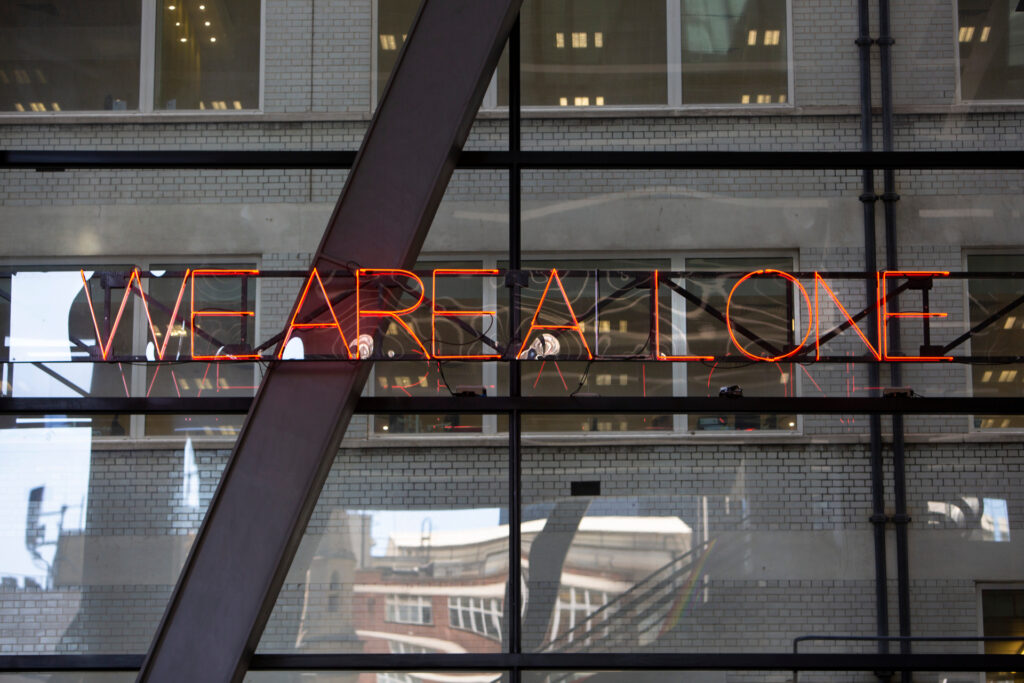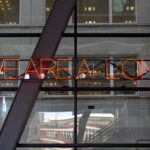
Photo: © Nick Turpin
When Jason Allen’s Théâtre D’opéra Spatial (2022) won the blue ribbon in the Colorado State Fair’s annual art competition in the category for digital art or digitally manipulated photography, there was a very strong outcry in the media that this signified the ‘end of art’. Allen himself was quoted in the New York Times saying “This isn’t going to stop. Art is dead, dude. It’s over. A.I. won. Humans lost.”
Generated artworks have provoked strong reactions with programs like DALL-E, Stable Diffusion, and Midjourney now capable of generating realistic, complex and often rather pleasing images. While many artists fear the consequences of this new technology, others are optimistic they can embrace it positively and make their creative process more effective. People have opposed and worried about new tools, materials, and technologies before, and while artists are right to be concerned, history teaches us that new technologies can give rise to new forms of expressions and make certain tasks more efficient or even more creative.
Existential concerns aside, the recognition of Allen’s work is a welcomed invitation to reflect, once again, on what art is and why we value it. As a potential user and appreciator of AI-generated artworks, my concerns come from a different direction. I worry whether the artists whose work the algorithms train on have consented to their work being used in this way. And I worry about the data used in the training. The artworld has not traditionally been a place of equality. Some perspectives have been more represented than others, and some perspectives are largely missing. This affects the kind of output programs trained on traditional artworks can deliver.
Take, for instance, women in art. The voices of female artists are largely missing from the artistic canon. The next time you visit a gallery, try to count how many artworks by women you can encounter. Then count how many paintings of apples or cabbages you can see. Chances are you will find more paintings of apples or cabbages than you will find works by women. As the art historian Katie Hessel recently wrote, only 1% of exhibited artworks in the National Gallery in London are by women. The number is significantly lower when we consider women of color. Only 11% of the artworks at New York’s MoMA are by women artists. These are not anomalies. A 2019 study of 18 major US galleries found that 85% of artists were white and 87% were men. The study also identified that American and French artists were disproportionately represented while 77 countries did not have a single piece exhibited in those galleries.
AI algorithms train on data based mostly on works created by (white) men. You might think that the gender of the author does not matter. If the apples or cabbages are properly depicted and the shadowing displays skill, what does it matter who made them? But other themes highlight how important diversity of perspectives is. Consider depictions of violence against women. From Greek sculpture to Renaissance paintings, many artworks take the male subject as central to the artwork. The male is often presented as powerless to his lust, and we are invited to empathize with his obsession and inability to resist. The female in the painting is often passive, deprived of voice and agency. In the rare cases where such scenes are depicted by female artists, we see a different perspective. In Susanna and the Elders (1610), drawn by Artemisia Gentileschi (1593-1653), we see a very different expression and depiction of the woman’s experience: the young woman in the painting is explicitly placing her arm and body to say ‘no’ to the two old men trying to seduce her. Gentileschi, sadly, created the work speaking from personal experience, having been sexually assaulted by her father’s friend at the age of 17 and even having to prove her innocence for the assault in court. But while Classical and Renaissance artworks populate online galleries, Gentileschi remains relatively unknown. Despite the fame and recognition she received during her lifetime—she was the first woman to become a member of the Academy of the Arts and Drawings in Florence—she was quickly erased from the history books.
Lack of diversity and representation also changes how we connect to the artwork. Take motherhood. Celebrated classics like Leonardo da Vinci’s Virgin of the Rocks (1483-1486) place the child at the center of the image. The mother fades in the background. Sitting calm and still, she looks deprived of agency. Such a scene has little to do with an actual mother’s lived experience. When, in contrast, conceptual artist Mary Kelly presented her Postpartum Document (1973-1979), part of which is a framed, soiled diaper, she captured something we do not find conveyed in canonical depictions of motherhood. Kelly’s work gets us to think of the different sides of motherhood—how painful and unpleasant, yet transformative and beautiful motherhood can be all at once. Even if you don’t like Kelly’s framed yellow splashes on the canvas and wouldn’t spend much time looking at them, this conceptual work conveys the confusing set of emotions any mother has felt. It is real. The authenticity of the mother’s lived experience is hardly to be found in the classic representations drawn by men. As wonderful as da Vinci’s work is, it is nice to see diversity of perspectives in our art.
In the 650 pages of E.H. Gombrich’s classic text The Story of Art, there is only a single female artist: Käthe Kollwitz (1867–1945), whose works depicts the effects of poverty on the working class. This sobering realization forces us to reconsider what data our algorithms are trained on and whether they will further perpetuate and amplify the inequalities still existing in our society. One of my worries is that our algorithms train on a biased sample. A further worry concerns the moral status of the artists whose artworks are in that training data set. We don’t know which images the program trains on. Imagine you are using AI to generate an innocent Viennese landscape. The program might give you a perfectly decent looking image in response to the prompt, but you might feel differently about it if you knew it was trained on images drawn by Hitler during his aspiring days as an artist in Austria. While the dozens of the landscapes he produced are not publicly exhibited, there are plenty of online galleries holding these images. There is no guarantee the algorithm will not train on these landscapes but you might not want to produce or look at an image that is partially based on his work.
While programs such as Midjourney, Stable Diffusion and DALL-E explicitly commit to monitoring the production of pornographic or offensive art and disabling certain prompts, this hardly resolves the issue once we consider the place of women in art history. So much of the artistic canon subjugates and objectifies women. Take Allen Jones’ controversial but nevertheless classic sculpture trio Hatstand, Table, and Chair (1969), which features three women in lingerie posturing as objects: a table, a chair and a hatstand. It is not hard to imagine that artworks degrading women and minorities, for instance, could be produced with similar prompting. How to deal with morally problematic art is a topic of philosophical debate and the artworld is constantly negotiating whether and how to exhibit morally controversial works. None of these subtleties are reflected in AI generated art.
Furthermore, while it is easy to train AI on images of Jones’ work, it would be difficult to ever recreate some of the most powerful artworks in feminist art, such as Maria Abramovic’s Rhythm 0 (1975). In this groundbreaking piece, the artist invited her audience to contribute to the creation of the piece by asking them to treat her as the artwork’s object. Abramovich left 72 items on the table near her as she stood still for the entire six-hour duration of the performance. While the audience explored the objects in the first hours of this work, it became progressively violent, with audience members sexually assaulting Abramovic, cutting her skin with a scalpel, and eventually putting a loaded gun in her hand against her head. This work came only 5 years after Jones’, but they ask you to reflect on the objectification of women in a very different way.
With all this in mind, it seems inevitable that algorithmic bias in AI-generated art will perpetuate and massively amplify inequality, and that AI-generated art could be used to produce hate speech by generating artworks that subjugate and oppress. But Jason Allen’s prize-winning AI-generated art, far from signifying the death of art, is a welcomed invitation for reflecting on what art is and why it is valued. I find it hard to reconcile with his claim that art is dead; he is after all still an artist using a new technology and loving the possibilities this technology has opened to him. For some art forms, AI generators will indeed be transformative. But the technology itself and the images it currently generates cannot themselves replace our need for human connection and authenticity. We value art for how it makes us feel and the artists for the way they manage to pack so much meaning with often a single brush stroke. Our grasp of the context in which an artwork is produced also significantly affects how we see the work and its value. We might struggle to assign much value to generated images exactly because they lack the authenticity and meaning we usually seek in artworks.
When Cambridge based artist Emma Smith created her work WE (2019), she wanted to capture the fragility of human relationships, our fear of being alone but also the paradoxical feeling that while we fear being alone, we are all together in sharing this fragility. The flickering L in her neon sign changing from “WE ARE ALL ONE” to “WE ARE ALONE” arouses so much emotion in us. I often thought of her artwork during the first lockdown in 2020, feeling an odd sense of comfort in the midst of the pain of the isolation we all experienced. She was able to bring this conflicting, unsetting and beautiful feeling to a visual medium in such a genius way. This authenticity and lived experience behind an artwork is what continues to be of value to us and perhaps, in the age of generated artworks, we will value this even more. So while artists like Allen might invite us to problematize on the concepts of arthood and collaborations with technology, they also get us to reflect on what makes art good and why we value it at all.
Dr Milena Ivanova is a philosopher of science interested in the relationship between science and art, creativity and the automation of discovery. She teaches at the Leverhulme Centre for the Future of Intelligence and the Institute of Continuing Education at the University of Cambridge. She is the author of Duhem and Holism, published by Cambridge University Press in 2021, and the co-editor of The Aesthetics of Science: Beauty, Imagination and Understanding (2020), and The Aesthetics of Scientific Experiments (2023).



November 18, 2023 at 7:51 am
I need to get reading glasses. That necessity has escaped my consciousness, until now: many blogs I read can be made larger. Yours cannot. I must fix that. I like the premise of this article, because I think AI art is a problem. My question is if there is *a real problem* with AI art, what is that problem? I suppose, in tracing technological advance and change, developments such as virtual reality heralded the notion of AI art. My beef here is foundational, in this sense. When certain goals, become attainable, we jump to attain them. Just because we can. And, because attainment meets the interests, motivations and preferences of others involved. So, carry on and I will get those *readers*.
Thanks!